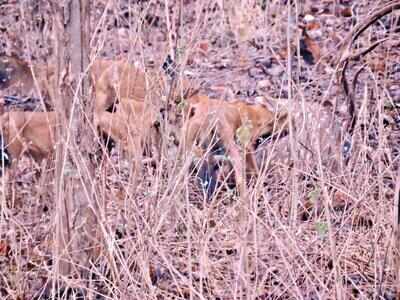
Nagpur: Scientists from Wildlife Conservation Society (WCS), India, University of Florida (USA), Wildlife Conservation Trust (WCT), and National Centre for Biological Sciences (NCBS) have proposed a framework for conserving the endangered dhole, also known as Asiatic wild dog, in India using a combination of ecological, social, political and administrative interventions.
Country-level species conservation plans serve as a blueprint for identifying important areas, prioritizing management actions and channelling conservation funds. India is a biologically mega diverse country, yet many threatened and endangered species do not have scientific conservation plans.
The researchers first made a detailed assessment of current status of dholes in each state. Based on the relationship between dhole occurrence, forest cover, protected areas, human population and cattle densities, they identified tehsils for targeting management interventions — areas where dhole population needs to be recovered, areas warranting improvement or expansion of forest habitats, and areas with potential for dholes to expand their distribution range.
The study also evaluated state-wise conservation capacity using multiple criteria, like GDP share, poverty levels, state and central budgetary allocations for forest and wildlife sectors, and rejection rate of forest clearances.
“Dholes play an important role as apex predators in forest ecosystems. Besides tiger, dhole is the only large carnivore in India that is under International Union for Conservation of Nature’s ‘endangered’ category. As a country that perhaps supports the highest number of dholes in the world, we still do not have targeted management plans for scientific monitoring of the species,” said Arjun Srivathsa, lead author of the study.
“Our study recognizes tehsils and states that need to be prioritized, and thereby offers a primer for designing a country-level plan to conserve their population,” he adds.
The study reports that Karnataka, Maharashtra and Madhya Pradesh ranked very high on the priority scale, and are adequately equipped to maintain status quo, consolidate forest habitats, and recover dhole population by increasing prey densities and reducing pressures on forests.
On the other hand, Arunachal Pradesh, Chhattisgarh, Odisha, Telangana and Goa will need to increase financial investments towards forest and wildlife sectors, and also resolutely reduce the ease of granting forest clearances for infrastructure projects.
Additionally, improving habitat conditions and prey densities in the Eastern Ghats of Andhra Pradesh, Telangana and Odisha would strengthen the link between dhole population in Western Ghats and Central India. Despite their endangered status, there is a persistent lack of resources and policy focus on dhole conservation.
“Alongside a comprehensive assessment of dholes in India, our study also provides an analysis of the current state of knowledge through a review of all published literature on the species. We identify critical gaps which can be explicated through improved funding for dhole research and conservation in India and across its distribution range,” said co-author Girish Punjabi.
The study titled ‘A strategic road map for conserving the endangered dhole (Cuon alpines) in India’ was published in the recent issue of reputed international journal Mammal Review.
The authors include Arjun Srivathsa (WCS–India & University of Florida), Sushma Sharma (WCS–India), Priya Singh (NCBS), Girish Punjabi (WCT), and Madan Oli (University of Florida).
Dholes occupy 49% of potential habitats in 685 of mainland India’s 2,342 sub-districts
Study reports that Karnataka, Maharashtra and Madhya Pradesh rank very high on priority scale
The study identified 143 sub-districts with potential for dhole population recovery, 145 for habitat recovery, and 404 for range expansion
Of 34 mainland states/Union Territories, 17 were identified as high priority for dhole conservation
Of these, 9 are adequately equipped to implement management actions to conserve dholes, while 8 need to improve capacity towards increasing likelihood of conservation success
Literature on dholes (from 1874 to 2019) was dominated by natural history notes, followed by distribution records and studies of population ecology
Review of published literature revealed significant knowledge gaps in terms of quantitative ecological assessments across all dhole range-countries
Country-level species conservation plans serve as a blueprint for identifying important areas, prioritizing management actions and channelling conservation funds. India is a biologically mega diverse country, yet many threatened and endangered species do not have scientific conservation plans.
The researchers first made a detailed assessment of current status of dholes in each state. Based on the relationship between dhole occurrence, forest cover, protected areas, human population and cattle densities, they identified tehsils for targeting management interventions — areas where dhole population needs to be recovered, areas warranting improvement or expansion of forest habitats, and areas with potential for dholes to expand their distribution range.
The study also evaluated state-wise conservation capacity using multiple criteria, like GDP share, poverty levels, state and central budgetary allocations for forest and wildlife sectors, and rejection rate of forest clearances.
“Dholes play an important role as apex predators in forest ecosystems. Besides tiger, dhole is the only large carnivore in India that is under International Union for Conservation of Nature’s ‘endangered’ category. As a country that perhaps supports the highest number of dholes in the world, we still do not have targeted management plans for scientific monitoring of the species,” said Arjun Srivathsa, lead author of the study.
“Our study recognizes tehsils and states that need to be prioritized, and thereby offers a primer for designing a country-level plan to conserve their population,” he adds.
The study reports that Karnataka, Maharashtra and Madhya Pradesh ranked very high on the priority scale, and are adequately equipped to maintain status quo, consolidate forest habitats, and recover dhole population by increasing prey densities and reducing pressures on forests.
On the other hand, Arunachal Pradesh, Chhattisgarh, Odisha, Telangana and Goa will need to increase financial investments towards forest and wildlife sectors, and also resolutely reduce the ease of granting forest clearances for infrastructure projects.
Additionally, improving habitat conditions and prey densities in the Eastern Ghats of Andhra Pradesh, Telangana and Odisha would strengthen the link between dhole population in Western Ghats and Central India. Despite their endangered status, there is a persistent lack of resources and policy focus on dhole conservation.
“Alongside a comprehensive assessment of dholes in India, our study also provides an analysis of the current state of knowledge through a review of all published literature on the species. We identify critical gaps which can be explicated through improved funding for dhole research and conservation in India and across its distribution range,” said co-author Girish Punjabi.
The study titled ‘A strategic road map for conserving the endangered dhole (Cuon alpines) in India’ was published in the recent issue of reputed international journal Mammal Review.
The authors include Arjun Srivathsa (WCS–India & University of Florida), Sushma Sharma (WCS–India), Priya Singh (NCBS), Girish Punjabi (WCT), and Madan Oli (University of Florida).
Conserving The Wild Dogs
Dholes occupy 49% of potential habitats in 685 of mainland India’s 2,342 sub-districts
Study reports that Karnataka, Maharashtra and Madhya Pradesh rank very high on priority scale
The study identified 143 sub-districts with potential for dhole population recovery, 145 for habitat recovery, and 404 for range expansion
Of 34 mainland states/Union Territories, 17 were identified as high priority for dhole conservation
Of these, 9 are adequately equipped to implement management actions to conserve dholes, while 8 need to improve capacity towards increasing likelihood of conservation success
Literature on dholes (from 1874 to 2019) was dominated by natural history notes, followed by distribution records and studies of population ecology
Review of published literature revealed significant knowledge gaps in terms of quantitative ecological assessments across all dhole range-countries
Quick Links
Kerala Coronavirus Helpline NumberHaryana Coronavirus Helpline NumberUP Coronavirus Helpline NumberBareilly NewsBhopal NewsCoronavirus in DelhiCoronavirus in HyderabadCoronavirus in IndiaCoronavirus symptomsCoronavirusRajasthan Coronavirus Helpline NumberAditya ThackerayShiv SenaFire in MumbaiAP Coronavirus Helpline NumberArvind KejriwalJammu Kashmir Coronavirus Helpline NumberSrinagar encounter
Get the app








